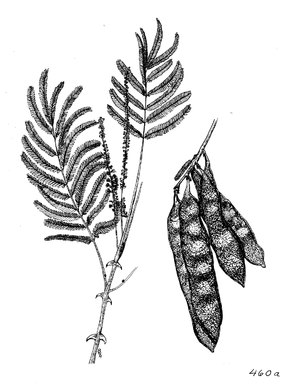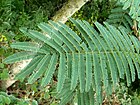Note: This is a project under development. The articles on this wiki are just being initiated and broadly incomplete. You can Help creating new pages.
Acacia polyacantha - Kadaraḥ
Kadaraḥ consists of dried pieces of heart wood of Acacia polyacantha. It is medium sized tree with white bark exfoliating in papery flakes with horizontal patches of darker colour. It is found throughout eastern and peninsular India.
Uses
Parts Used
Chemical Composition
An alkaloid diaboline, β-sitosterol, stigmasterol, oleanolic acid and its 3β-acetate, a saponin containing oleanolic acid, galactose, mannose.[1]
Common names
| Language | Common name |
|---|---|
| Kannada | Kaggali |
| Hindi | Safed khair |
| Malayalam | Venkaringali, Somarayattoli |
| Tamil | Kovil, Shilaiyunchai |
| Telugu | Tellatumma, Tellasundra, Tellachandra |
| Marathi | NA |
| Gujarathi | NA |
| Punjabi | NA |
| Kashmiri | NA |
| Sanskrit | Somavalkaḥ, Svetakhadiraḥ |
| English | White Cutch tree, White Catechu |
Properties
Reference: Dravya - Substance, Rasa - Taste, Guna - Qualities, Veerya - Potency, Vipaka - Post-digesion effect, Karma - Pharmacological activity, Prabhava - Therepeutics.
Dravya
Rasa
Tikta
Guna
Viṣada
Veerya
Śīta
Vipaka
Kaṭu
Karma
Kaphahara, Varṇya, Pittahara, Raktaṣodhaka
Prabhava
Habit
Identification
Leaf
| Kind | Shape | Feature |
|---|---|---|
| Alternate | Bipinnate | Leaf Shape is Elliptic and Leaf Apex is Subacute-obtuse |
Flower
| Type | Size | Color and composition | Stamen | More information |
|---|---|---|---|---|
| Unisexual | 4-8cm long | Yellowish-white | Many | Flowering from March-June |
Fruit
| Type | Size | Mass | Appearance | Seeds | More information |
|---|---|---|---|---|---|
| Oblong pods | 10-15 | Fruiting from August-February | Flat brown pod | seeds 5-8 | Fruiting throughout the year |
Other features
List of Ayurvedic medicine in which the herb is used
Where to get the saplings
Mode of Propagation
How to plant/cultivate
The white thorn tree grows in tropical areas at elevations from 200 - 1,800 metres. It prefers areas where the mean annual rainfall is in the range 300 - 1,000mm Prefers sites with a high groundwater table, indicating eutrophic and fresh soils. Prefers alluvial soils with a good mix of clay and sand, though it occasionally prospers on stony slopes and compacted soils.[3]
Commonly seen growing in areas
Photo Gallery
References
- ↑ The Ayuredic Pharmacopoeia of India Part-1, Volume-5, Page no-89
- ↑ Morphology
- ↑ Cultivation detail
External Links
- Ayurvedic Herbs known to be helpful to treat Snake bites
- Ayurvedic Herbs known to be helpful to treat Venereal diseases
- Ayurvedic Herbs known to be helpful to treat Dysentery
- Ayurvedic Herbs known to be helpful to treat Gastro intestinal disorders
- Ayurvedic Herbs known to be helpful to treat Head sores
- Herbs with Seeds used in medicine
- Herbs with Fruits used in medicine
- Herbs with common name in Kannada
- Herbs with common name in Hindi
- Herbs with common name in Malayalam
- Herbs with common name in Tamil
- Herbs with common name in Telugu
- Herbs with common name in Sanskrit
- Herbs with common name in English
- Habit - Deciduous tree
- Index of Plants which can be propagated by Seeds
- Herbs that are commonly seen in the region of Widespread
- Herbs that are commonly seen in the region of Grasslands
- Herbs that are commonly seen in the region of Alluvial clays
- Herbs
- Fabaceae
- Ayurvedic herbs that don't have seed photos






